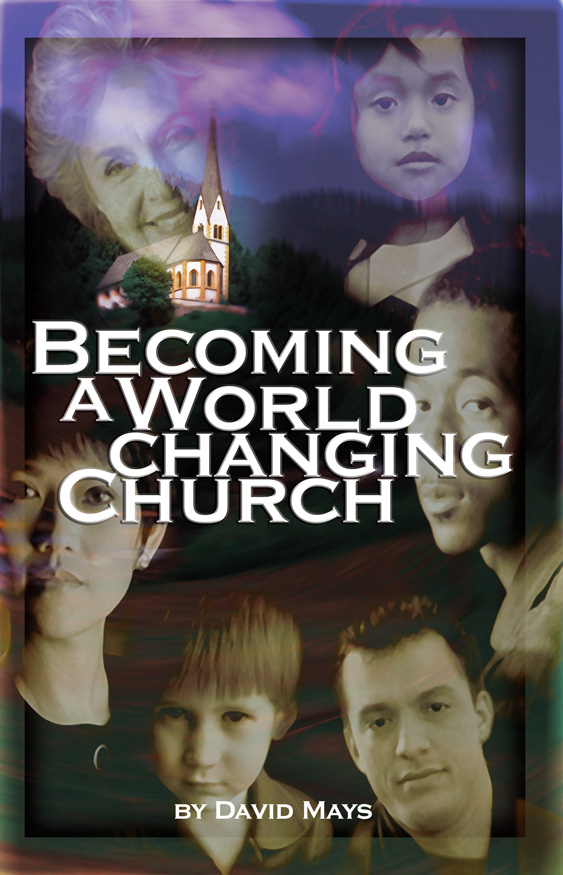|
|
MayBeco
06-4-56 BECOMING
A WORLD CHANGING CHURCH David Mays ACMC, 2006, 32 pp.,
ISBN 1-930924-31-3 Available from on-line store at www.acmc.org
|
|
David Mays is the Great Lakes Regional Director for ACMC and the author of several practical resources on missions for the local church as well as these book notes. This newly-released 32-page booklet is the compilation of six articles published in the ACMC quarterly, Mobilizer, under the topic “Your Church and Its Mission.” The ACMC Mobilizer is sent automatically to ACMC partners and donors. “God wants your church to make an impact in the world—not just your world, but the greater world—for His glory in all the earth.” (from the back cover) Many books on doing church cite the Great Commission as the church’s marching orders, identify the core of the Great Commission as “making disciples,” and give primary attention to reaching people like you in your own community. The “all nations” part of the Great Commission is often treated in a page or two near the back of the book under “missions.” This concept takes a fresh approach to making the Great Commission the central organizing principle of a church. The first part
argues that “all nations” or “all the earth” is an integral part of the
overriding purpose and mission of the church. “When I think of the purpose of the Church as glorifying God, it gives me perspective if I think of it as His glory, His reputation, in all the earth. When I think of the purpose of the Church as worship, it gives me perspective if I think of it as the worship of God, or the honoring of God, among all peoples.” (5) “If the purpose of the Church (the reason it exists) is God’s glory, or worship, or loving others, then the mission of the Church (its primary task) is to give itself toward the realization of the day when He is worshiped, honored, loved, and obeyed by all peoples on earth. A clear understanding of this purpose can bring great focus to a church.” (6) “The ‘all nations’ of the Great Commission can conveniently be thought of in three major groups: · People like us nearby · People unlike us nearby · People unlike us far away A major issue for our churches is how much effort we are giving toward evangelizing and discipling each of the three groups.” (6) The second part helps church leaders look objectively at their priorities and use of resources. It raises the issue of balancing the church’s resources. Proximity, church strength, gospel access, spiritual understanding, concentrations of people, available resources, and opportunity are some possible factors to help determine the level of investment in the three groups (above). The third part outlines what a globally-focused church might look like. Leadership, communication, prayer, spiritual formation, congregational involvement, strategic ministries, and a global ethos characterize such a church. “A globally-focused church utilizes every possible avenue to maximize its impact in the whole world.” (14) “The extension of God’s glory in all the earth is the overarching theme that gives focus and direction to all planning, budgeting, decisions, and ministries.” (14) The fourth part
discusses the relationship between purpose and ministries. “Purpose precedes ministry.” (20) “Purpose affects every ministry.” (21) “Purpose guides every ministry.” (21) “The purpose of the whole is the purpose of the parts.” (22) “It takes leaders gripped by God’s purpose, continually inspired and informed by the Holy Spirit, and operating according to a system that continually reinforces the purpose.” (21) The fifth part
approaches the concept of implementing change. “The qualities needed for leadership in general, and change management in particular, would be considered overwhelming to most people. (And those who aren’t overwhelmed probably overestimate themselves.)” (22) “Prayer is critical to vision development. Here’s why: We see what we are looking for; we often miss what we don’t expect to see….[Prayer] keeps us on the lookout for His intervention.” (23, quoting Andy Stanley) Guiding the change process includes assembling a leadership team, building bridges to key influencers, preparing the church for change, respecting the past, defining changing roles, empowering by granting permission, measuring progress, and celebrating victories. (24-26) Some excellent references are provided. The sixth part
examines the roles of church leaders in light of the mission. “The first step to becoming a church that mobilizes its members for the Great Commission is to begin with the highest levels of leadership.” (27) The church’s purpose comprises the core of the senior pastor’s discipling of church leaders and vision casting for the congregation. All staff and lay leaders build their ministries around fulfilling the purpose. “And so it goes with every staff member [and lay leader]. The position, the goal, the responsibilities, the activities – the job – is looked at from the perspective of the big global goal.” (29) “What I hope is that these elders will see themselves, the church’s members, and the whole church’s life and ministry in the context of a world for which Christ died. I want them to make all of their decisions in light of how those decisions will influence the involvement of the whole church in reaching the nations. I want their lives to be so permeated with the missional purpose of the church that they can not help but be affected in how they act, plan, evaluate, communicate and lead.” “The purpose is the guiding factor for leaders.” (30) * * * * * |
|
